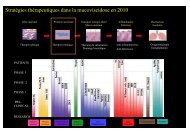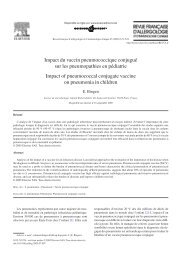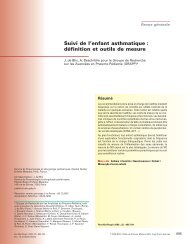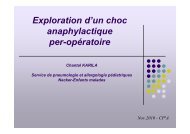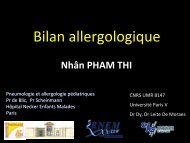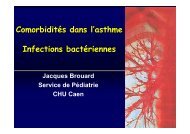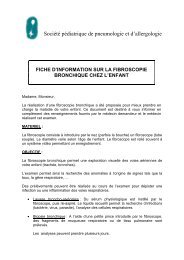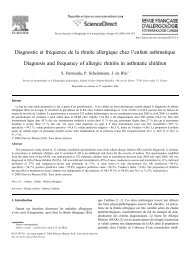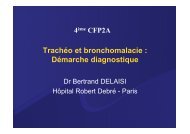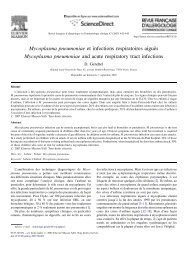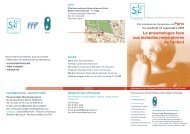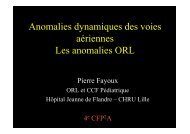Imagerie dans l'asthme - Société pédiatrique de pneumologie et d ...
Imagerie dans l'asthme - Société pédiatrique de pneumologie et d ...
Imagerie dans l'asthme - Société pédiatrique de pneumologie et d ...
Create successful ePaper yourself
Turn your PDF publications into a flip-book with our unique Google optimized e-Paper software.
IMAGERIE DE<br />
L’ASTHME<br />
CFP2A<br />
Dr L. Berteloot<br />
Service <strong>de</strong> Radiologie Pédiatrique<br />
Hôpital Necker-Enfants Mala<strong>de</strong>s, Paris
Radioprotection<br />
Co<strong>de</strong> <strong>de</strong> santé publique<br />
Réglementation en radioprotection concernant les patients soumis à<br />
<strong>de</strong>s radiations ionisantes à <strong>de</strong>s fins médicales (Décr<strong>et</strong> N°c2002-<br />
460 du 24/03/2003) dérivant <strong>de</strong> la directive européenne Euratom<br />
97/43.<br />
Justification <strong>de</strong> l’acte<br />
<br />
<br />
Gui<strong>de</strong> du Bon Usage <strong>de</strong>s Examens d’<strong>Imagerie</strong> Médicale<br />
Echange préalable entre le <strong>de</strong>man<strong>de</strong>ur <strong>et</strong> le réalisateur <strong>de</strong> l’acte,<br />
Optimisation <strong>de</strong>s doses<br />
<br />
<br />
<br />
Préparation <strong>et</strong> encadrement du patient <strong>et</strong> <strong>de</strong> ses parents<br />
Gui<strong>de</strong>s <strong>de</strong> procédures radiologiques (SFR)<br />
Protocole pour obtenir niveau <strong>de</strong> dose le plus faible<br />
raisonnablement possible, recommandations <strong>de</strong> la (SFIPP)
Métho<strong>de</strong>s d’<strong>Imagerie</strong> <strong>de</strong> l’Asthme<br />
Radiographie Standard<br />
Scanner<br />
IRM
Radiographie Standard<br />
Indications:<br />
<br />
<br />
Premier Episo<strong>de</strong><br />
Signes <strong>de</strong> gravité, dyspnée brutale, fièvre<br />
Objectifs:<br />
<br />
<br />
Rechercher une autre cause <strong>de</strong> dyspnée expiratoire<br />
Rechercher signes <strong>de</strong> complication: infection, pneumothorax,<br />
pneumomédiastin…
Métho<strong>de</strong>s d’<strong>Imagerie</strong> <strong>de</strong> l’Asthme<br />
Radiographie Standard<br />
Scanner<br />
IRM
Scanner Thoracique avec iMdC<br />
Indication:<br />
Asthme mal contrôlé (malgré traitement <strong>de</strong> fond par corticoï<strong>de</strong>s<br />
inhalés)<br />
Doute diagnostique: sympômes atypiques, stridor, symptômes entre<br />
les épiso<strong>de</strong> ou <strong>de</strong>puis la naissance<br />
Anomalie Rx, fibroscopie<br />
Bilan compl<strong>et</strong> en milieu spécialisé:<br />
Bilan allergologique, immunologique, endoscopie bronchique, étu<strong>de</strong> <strong>de</strong><br />
la motilité ciliaire, test <strong>de</strong> la sueur, pHmétrie…<br />
Intérêt:<br />
Diagnostic différentiel<br />
Évaluation non invasive du remo<strong>de</strong>lage <strong>de</strong>s voies aériennes
Métho<strong>de</strong>s d’<strong>Imagerie</strong> <strong>dans</strong> l’Asthme<br />
Radiographie Standard<br />
Scanner<br />
IRM
IRM thoracique<br />
Développement en cours<br />
<br />
<br />
<br />
<strong>Imagerie</strong> <strong>de</strong> perfusion<br />
<strong>Imagerie</strong> <strong>de</strong> Ventilation<br />
Acquisitions Dynamiques<br />
Place à Définir
Radiographie Standard<br />
du Thorax
Acquisition<br />
Collaboration nulle ou quasi jusqu’à environ 3 ans: préparation, contention,<br />
pas <strong>de</strong> sédation en radiologie standard.<br />
Apnée pas avant 5-6 ans<br />
Cliché <strong>de</strong> Face<br />
Inci<strong>de</strong>nce AP<br />
Décubitus<br />
Inci<strong>de</strong>nces complémentaires non indiquées en première intention
Radio Standard<br />
Normale en pério<strong>de</strong> inter-critique ou<br />
Syndrome Bronchique<br />
<br />
Signes Directs<br />
Epaississement <strong>de</strong>s parois bronchiques:<br />
<br />
<br />
<br />
opacités linéaires en rail ou en anneau prédominant en péri-hilaire.<br />
Dilatation <strong>de</strong>s lumières bronchiques<br />
Impactions Mucoï<strong>de</strong>s<br />
<br />
Signes Indirects<br />
Distention thoracique:<br />
aplatissement <strong>de</strong>s coupoles,<br />
visualisation > 6è arc antérieur,<br />
horizontalisation <strong>de</strong>s côtes,<br />
raréfaction vasculaire<br />
Piégeage aérique<br />
Atélectasie
10 ans
Scanner Thoracique
Acquisition<br />
Jeûne Non requis<br />
Sédation<br />
Rarement après 3 ans (mise en confiance, pose du cathlon <strong>dans</strong> un autre<br />
service…)<br />
Contention sur planche pour les nourrissons +/- prémédication<br />
Injection<br />
Périphérique si possible (éviter plis du cou<strong>de</strong>)<br />
Injecteur automatique (débit <strong>et</strong> pression contrôlés) sauf KTC<br />
1 mL/ kg, débit adapté au cathlon (entre 0.5 <strong>et</strong> 1.5 mL/sec)<br />
Apnée +/- expiration, possible après 6 ans.<br />
Modulation <strong>de</strong> dose<br />
80 kV si poids < 45 kg.<br />
Modulation automatique <strong>de</strong>s mAs
Acquisition<br />
Acquisition hélicoïdale<br />
Coupes jointives <strong>de</strong> 0.6 à 1.2 mm d’épaisseur<br />
Filtres reconstruction:<br />
Fenêtre médiastinale: filtre « mou »<br />
N= 400, W= 40<br />
Fenêtre parenchymateuse: filtre « dur »<br />
N = -600, W = 1600<br />
Algorythmes <strong>de</strong> reconstruction<br />
MPR: MIP- MiniP<br />
VR: endoscopie virtuelle, volume pulmonaire…
Scanner Thoracique<br />
Diagnostic Différentiel d’Asthme
Causes <strong>de</strong> toux chronique ou dyspnée<br />
obstructive<br />
Obstruction proximale<br />
CE<br />
Sténose trachéale ou bronchique,<br />
Malformations broncho-pulmo<br />
Tumeurs bénignes ou malignes,<br />
ADP compressives,<br />
Anomalie <strong>de</strong>s arcs aortiques,<br />
Artère pulmonaire gauche<br />
Trachéo-broncho-malacie<br />
Obstruction distale<br />
Mucovicidose,<br />
Dysplasie bronchopulmonaire,<br />
Dyskinésie ciliaire primitive,<br />
Séquelles <strong>de</strong> pneumopathie virale.<br />
Pathologie d’inhalation<br />
Fistule oeso-trachéale<br />
Fausses routes<br />
RGO<br />
DDB<br />
Déficit immunitaire (humoral +++),<br />
Pathologie interstitielle chronique<br />
(nourrisson)<br />
Poumon éosinophile<br />
Cardiopathie congénitale avec shunt<br />
droit-gauche<br />
Insuffisance cardiaque<br />
Dyskinésie <strong>de</strong>s cor<strong>de</strong>s vocales (ado)<br />
Syndrome d’hyperventilation<br />
J <strong>de</strong> Blic. Pneumologie Pédiatrique 2009
15 mois
15 mois
Collapsus trachéal +/- bronchique.<br />
Réduction <strong>de</strong> calibre <strong>de</strong> plus <strong>de</strong> 50 % <strong>de</strong> la surface trachéale au<br />
cours du cycle expiratoire.<br />
Frown sign.<br />
Formes primaires rares, formes secondaires (intubation,<br />
compression, anomalies <strong>de</strong>s arcs vasculaires, fistules<br />
oesotrachéales).
Asthme hyper-sécrétant
DCP
insp<br />
exp
Scanner Thoracique<br />
Evaluation <strong>de</strong> l’atteinte bronchique
Pas <strong>de</strong> données sur l’épaisseur normale<br />
<strong>de</strong>s bronches chez l’enfant<br />
Accentuation <strong>de</strong> la visibilité <strong>de</strong>s bronches<br />
<strong>dans</strong> le tiers externe du poumon
Scores significativement plus élevés chez les patients<br />
asthmatiques que chez les suj<strong>et</strong>s controles. Non corrélés aux<br />
EFR.<br />
Critère objectif <strong>de</strong> l’épaississement bronchique<br />
Marchac V. Thoracic CT in pediatric patients with difficult-to-treat asthma. AJR. 2002
Epaississement <strong>de</strong>s parois bronchiques (BWT) corrélé avec<br />
épaisseur <strong>de</strong> RBM <strong>et</strong> production <strong>de</strong> NO mais pas avec les EFR<br />
J <strong>de</strong> Blic J High-resolution computed tomography scan and airway<br />
remo<strong>de</strong>ling in children with severe asthma. Allergy Clin Immunol. 2005<br />
<br />
<br />
Pas <strong>de</strong> corrélation mise en évi<strong>de</strong>nce entre BWT, épaisseur <strong>de</strong> RBM <strong>et</strong><br />
FEV1<br />
Saglani S Can HRCT be used as a marker of airway remo<strong>de</strong>lling in<br />
children with difficult asthma? Respir Res. 2006
PY Brill<strong>et</strong>. Quantification of bronchial dimensions at MDCT using<br />
<strong>de</strong>dicated software Eur Radiol (2007)
HRCT - Remo<strong>de</strong>lage <strong>de</strong>s VA<br />
<br />
Coxson HO. Quantitative computed Tomography of chronic<br />
obstructive pulmonary disease. Acad Radiol 2005<br />
<br />
Brill<strong>et</strong> PY. Quantification of bronchial dimensions at MDCT<br />
using <strong>de</strong>dicated software. Eur Radiol 2007<br />
<br />
Montaudon M. Assessment of airways with threedimensional<br />
quantitative thin sectionCT: in vitro and in vivo<br />
validation. Radiology 2007
HRCT - Remo<strong>de</strong>lage <strong>de</strong>s VA<br />
<br />
Epaississement <strong>de</strong>s parois bronchiques (BWT) évalué en<br />
scanner :<br />
<br />
Significatif par rapport à <strong>de</strong>s suj<strong>et</strong>s contrôles (3è génération)<br />
<br />
Corrélé au remo<strong>de</strong>lage <strong>de</strong>s parois bronchiques décrit<br />
histologiquement: RBM - hétérogénéité.<br />
<br />
Corrélé à la sévérité <strong>de</strong> l’asthme évaluée cliniquement (EFR)<br />
<br />
Corrélé à l’évolution sous traitement<br />
<br />
Lee YM, High-resolution CT findings in patients with near-fatal asthma: comparison of patients with<br />
mild-to-severe asthma and normal control subjects and changes in airway abnormalities following<br />
steroid treatment. Chest 2004.<br />
<br />
Gono H. Evaluation of airway wall thickness and air trapping by HRCT in asymptomatic asthma. Eur<br />
Respir J 2003.
•Inspiration<br />
•Expiration
HRCT-Mosaïque <strong>et</strong> Piégeage Aérique<br />
<br />
Busacker A. Multivariate analysis of risk factors for air-trapping<br />
asthmatic phenotype as measured by quantitative CT analysis.<br />
Chest 2009
HRCT-Mosaïque <strong>et</strong> Piégeage Aérique<br />
<br />
The PI at -910 HU<br />
Positively correlated with % predicted TLC, total gas volume (TGV),<br />
and ECP level and IOS bronchodilator reversibility<br />
Inversely correlated with FEV(1)/forced vital capacity (FVC) and %<br />
predicted forced expiratory flow b<strong>et</strong>ween 25-75% FVC (FEF(25-<br />
75)). and also correlated positively with.<br />
This data suggest that quantitative HRCT may be a useful tool in the<br />
evaluation of peripheral airflow obstruction in children with asthma.<br />
<br />
Jain N Quantitative computed tomography <strong>de</strong>tects peripheral airway<br />
disease in asthmatic children Pediatr Pulmonol. 2005
IRM thoracique
ARM<br />
Visualisation 3D<br />
Nouvelles séquences sans injection <strong>de</strong> gadolinium<br />
HU Kauczor Imaging of Pulmonary Pathologies Focus on<br />
Magn<strong>et</strong>ic Resonance Imaging ATS 2009
IRM <strong>de</strong> perfusion<br />
<br />
<br />
Validée par rapport à la scintigraphie <strong>de</strong> perfusion<br />
acquisition à lieu à un temps donné (pic <strong>de</strong> réhaussement)<br />
évolution vers l’évaluation du temps <strong>de</strong> remplissage<br />
capillaire (4D)<br />
IRM <strong>de</strong> perfusion chez un patient atteint <strong>de</strong> mucovicidose<br />
HU Kauczor 2009
IRM <strong>de</strong> Ventilation<br />
Hyperpolarised 3He MRI versus HRCT in COPD and<br />
normal volunteers. Van Beek Eur Respir J. 2009<br />
N VEMS=88% VEMS=23%
HPHe-3 MRI with MDCT showing ventilation <strong>de</strong>fects during the breath-hold in a subject with<br />
mild-mo<strong>de</strong>rate asthma. During the forced exhalation, residual signal due to gas trapping is<br />
evi<strong>de</strong>nt in MRI and air trapping is confirmed in MDCT during breath-hold at FRC<br />
James H. Holmes. Three Dimensional Imaging of Ventilation Dynamics in<br />
Asthmatics Using Multi-echo Projection Acquisition with Constrained<br />
Reconstruction Magn Reson Med. 2009
IRM <strong>de</strong> Ventilation<br />
Défects <strong>de</strong> ventilation<br />
<br />
Présents chez <strong>de</strong>s patients atteints d’asthme avant l’altération <strong>de</strong>s<br />
EFR<br />
<br />
<br />
Volume corrélé au déclin <strong>de</strong> la FEV1<br />
Disparaissent partiellement après bronchodilatation <strong>et</strong><br />
parallèlement à l’amélioration <strong>de</strong> la FEV1 puis réapparaissent <strong>dans</strong><br />
les mêmes régions<br />
<br />
<br />
De Lange EE The variability of regional airflow obstruction within the lungs of patients with<br />
asthma: assessment with hyperpolarized helium-3 magn<strong>et</strong>ic resonance imaging. J Allergy<br />
Clin Immunol 2007.<br />
Altes TA Hyperpolarized 3He MR lung ventilation imaging in asthmatics: preliminary<br />
findings. J Magn Reson Imaging 2001.
Cancer Imaging (2006) Imaging tumour motion for radiotherapy planning using<br />
MRI Hans-Ulrich Kauczor and Christian Plathow
Junichi Tokuda Lung Motion and Volume Measurement by Dynamic 3D<br />
MRI Using a 128-Channel Receiver Coil. Acad Radiol. 2010
Radiographie standard AP examen <strong>de</strong> choix <strong>dans</strong> l’asthme<br />
<br />
Scanner avec PdC indiqué <strong>dans</strong> <strong>de</strong>s cas sélectionnés<br />
-Diagnostic différentiel: arcs vasculaires <strong>et</strong> BO post I ++<br />
-Quantification objective in vivo du remo<strong>de</strong>lage <strong>de</strong>s VA <strong>et</strong><br />
du piégeage aérique<br />
<br />
IRM<br />
<br />
<br />
-informations morphologiques <strong>et</strong> fonctionnelles<br />
-nouvelles données sur la physiopathologie <strong>de</strong> l’asthme
Merci



